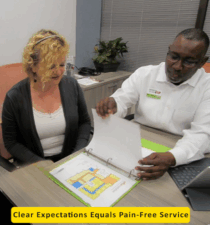
Your floors are one of the most valuable assets in your building. Your tenants—and the clients who visit their offices—make judgments about your tenants’ professionalism based, in part, on the appearance of your building’s interior, and while your building does not need fancy furniture or pricey pictures, it does need floors that appear to be expertly maintained. As a building owner, facility director, or property manager, you probably use one of these approaches to care for your floors: preventive or reactive.
There are two main approaches to floorcare introduced to most facility managers, neither of which I recommend, but I’m discussing them here because they’re the most commonly-introduced ways to care for commercial floors, and I want you to know what they are so you can avoid them.
Next week I will be telling you about a third method – the one I use and recommend – but for now, I want you to be familiar with the two most common methods.
Preventive
If your floors are cleaned once a week and receive maintenance once a month, for example, this is your approach. By sticking to a schedule your floors receive care on a regular basis. There are advantages to this approach. First, it keeps your floors looking well maintained. Second, since floor-care staff are cleaning and maintaining your floors regularly, they will spot minor problems before they before major problems.
Surprisingly, it wasn’t until the 1980’s and 1990’s that building owners, facility directors, and property managers began embracing this proactive approach. Before then, they relied on the reactive approach, so their floors weren’t cleaned until they were dirty, and their floors didn’t receive maintenance until they showed signs of deterioration.
There are also disadvantages. First, this approach won’t keep your floors from deteriorating prematurely. Second, it ignores manufacturer’s recommendations, which will void your warranties. Third, it will cause your floors to show these signs of improper care:
Carpet: stains, tears, an odor, and/or tenants complaining about their allergies
Marble: stains
Porcelain: dirty grout and a slippery surface
Tile: streaks
Wood: peeling, deep scratches, and/or dullness
Fourth, by relying on this approach, you’ll spend lots more than you need to. Here’s an example. Assume your building’s first floor has five times as much traffic as its fifth floor. Would you clean them equally as often? Of course not. Floors should be cleaned according to their traffic patterns, so in this example, the first floor should be cleaned more often than the fifth.
Reactive
If your floors are only cleaned after you’ve contacted your floor-care provider to come out and clean them, this is your approach. So your floors don’t receive care on a regular basis. The advantage to this approach is, you’ll spend less on maintenance than you would have had you used the preventive approach. But, this lone advantage is outweighed by a slew of disadvantages. First, your floors will deteriorate prematurely. Second, they will show signs of improper care. Third, like with the preventive approach, you’ll spend more than you need to. This table compares costs for the two approaches on a 500,000 sq. ft. building:

When you consider how valuable your floors are, you realize that the reactive approach is a poor choice. In some cases, though, it isn’t the building owner, facility director, or property manager who’s at fault—it’s the floor-care provider who provides reactive service. How? Some floor-care providers fail to inspect their clients’ floors for signs of trouble. Instead, they wait for their clients to find and report trouble spots. Other floor-care providers—when they do find signs of trouble—ignore them and, again, wait for their clients to find and report them.
You have probably been introduced to one of, if not both of these methods – you may even use one of them – but as I said, I don’t recommend them. Why? Because if you want your floors to retain their original beauty and last as long as possible, and if you want to accomplish both while minimizing the amount you spend on floorcare, these approaches won’t help you.
Instead, you’ll need a floor-care provider who knows a third approach, which will allow you to accomplish all three. Look for my next blog where I explain the approach to floorcare that I recommend.

Mo Bashar, I.C.E. GB
Facility Care Specialist
913-322-6200
Contact Us to let us know how we can help you!



